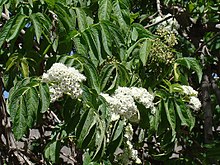| Sambucus peruviana | |
|---|---|

| |
| Leaves and inflorescences | |
|
Scientific classification
| |
| Kingdom: | Plantae |
| Clade: | Tracheophytes |
| Clade: | Angiosperms |
| Clade: | Eudicots |
| Clade: | Asterids |
| Order: | Dipsacales |
| Family: | Adoxaceae |
| Genus: | Sambucus |
| Species: | S. peruviana
|
| Binomial name | |
| Sambucus peruviana | |
| Synonyms [2] | |
| |
Sambucus peruviana is a species of tree in the family Adoxaceae. It is native to Central America and South America. [3]
Description
Trees up to 8 m, irregular trunk. [4] [5] Leaves compound, with 7-9 ovate-oblong leaflets, margin serrate, acute apex, hairy underside. [4] [5] The inflorescences are cymes 18–22 cm long, with white fragrant flowers. [4] [5] The fruits are black berries 1.2 cm in diameter, with 3-5 seeds. [4] [5]
Distribution and habitat
Sambucus peruviana is found from Costa Rica and Panama down the Andes south to northwestern Argentina between 2800 and 3900 m of elevation. [3] [5]
Vernacular names
Sauco (Colombia, Peru, Bolivia), kiola (Argentina), r'ayan (Quechua language). [3] [4]
Uses
The fruits can be made into jams, drinks, and wines. [5] [6] The leaves, flowers and fruits have medicinal properties; analgesic, antiinflammatory, antiseptic, sudorific. [5] [7] The wood is hard and resistant, used for construction, tools and making of quenas. [5] [6]
References
- ^ Condit, R. (2019). "Sambucus peruviana". IUCN Red List of Threatened Species. 2019: e.T151212245A151957327. doi: 10.2305/IUCN.UK.2019-3.RLTS.T151212245A151957327.en. Retrieved 29 April 2022.
- ^ "Sambucus peruviana Kunth". Plants of the World Online. Accessed 29 April 2022. [1]
- ^ a b c Grandtner, M. M.; Chevrette, Julien (2013). Dictionary of Trees, Volume 2: South America: Nomenclature, Taxonomy and Ecology. Academic Press. p. 582. ISBN 9780123969545.
- ^ a b c d e Evolucion Y Tecnologia de la Agricultura Andina (in Spanish). IICA. p. 160.
- ^ a b c d e f g h Geilfus, Frans (1994). El árbol al servicio del agricultor: Guía de especies (in Spanish). Bib. Orton IICA / CATIE. p. 481. ISBN 9789977571744.
- ^ a b Walker, Barry; Cheshire, Gerard; Lloyd, Huw (2007). Peruvian Wildlife: A Visitor's Guide to the High Andes. Bradt Travel Guides. p. 29. ISBN 9781841621678.
- ^ Duke, James A. (2008). Duke's Handbook of Medicinal Plants of Latin America. CRC Press. p. 606. ISBN 9781420043174.
External links
- IUCN Red List least concern species
- Sambucus
- Flora of the Andes
- Crops originating from Ecuador
- Crops originating from Peru
- Trees of Peru
- Trees of Ecuador
- Trees of Bolivia
- Trees of Argentina
- Trees of Colombia
- Trees of Costa Rica
- Trees of Panama
- Yungas
- Flora of the Southern Andean Yungas
- Dipsacales stubs
